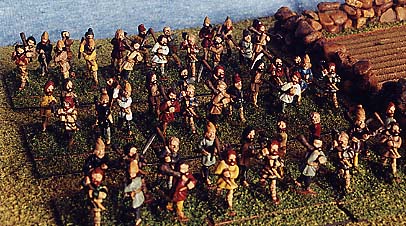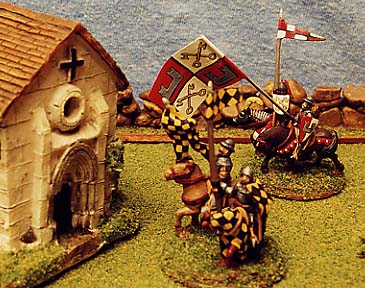
I made it a point when I started out this project to paint the troops as generically as possible. So much of what I own, Picts, Jacobites, Egyptians, etc., are pretty much unmistakable as that nation and have trouble being "passed off" as another on the tabletop. I didn't want my Medieval troops to be, say, Italian Condotta down to the "T," but be a stretch as War of the Roses.
Thus, the colors and patterns are very generic, and hopefully enable me to use these guys for just about any Medieval European army I choose.

The main strike arm of just about any Medieval European army are its mounted knights. It wouldn't be too much exaggeration to say that Medieval generals looked at the rest of the army as filler. It is with the knights that battles would be won or lost. If their charge is timed and supported properly, it was felt they would sweep away the opposition. If committed piecemeal or outflanked, they could be beaten.
I painted these guys according to the "rules of Heraldry," which sets out two "Metals" (White/Silver and Gold/Yellow), and "Five Colors" (Red, Black, Blue, Green, Purple). You may not put a metal on metal, or color on color, so no alternating red and black stripes, for example. It must be red and white or yellow, if stripes are the pattern chosen. The knights below are 15mm Essex.
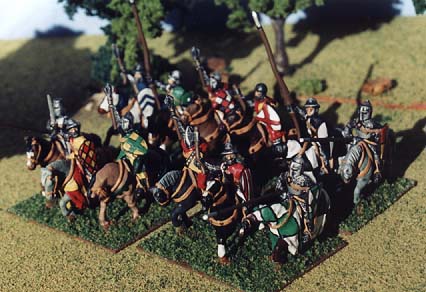
These guys were mounted men-at-arms, usually less heavily armored than their knightly employers. They were either brought along by each knight or hired as mercenaries to fill out the ranks of the knights. The figures below are 15mm Rank and File. I love Rank and File's foot, but am ambivalent about their mounted. They come in two pieces -- not rider and horse, but with the man's lower body moulded onto the mount. They torso and above is glued onto this, which is easier said than done, I found. Still, they look nice, if not as eye-catching as the knights.
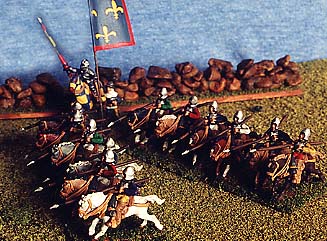
Infantry armed with various types of pole arms were used by most Medieval European armies to deal with opposing heavy horsemen. Some were designed to hook the rider from his saddle and throw him to the ground, where he would be more vulnerable. Others were designed to keep him at a distance, much like a pike, or even to hack through the knight's heavy armor. These guys are 15mm from Rank and File miniatures and come in a multitude of poses, with a variety of weapons. I'd recommend checking to make sure the pole weapons will fit in your carrying cases first, because they are easy to trim down to appropriate length BEFOREHAND.
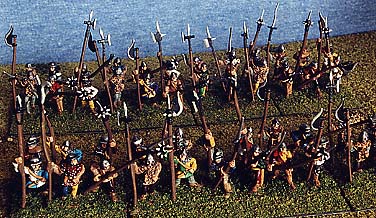
For awhile, the English longbowman reigned supreme on Medieval battlefields. They shattered the highly regarded chivalry of France in a series of battles. They beat the French knights both when they were mounted and afoot. As such, the longbowman became a highly demanded mercenary and could be found in armies throughout Europe.
The figures below are once again 15mm Rank and File. They come with a strange quiver that is meant to attach to their back, but after several tries, I could not get them to look good and painted them up without it.
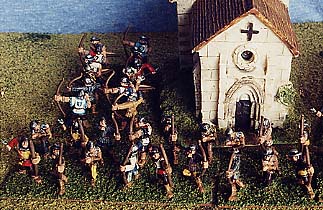
The Continental counterpart to the English longbowman was the crossbowman. These were also found in armies throughout Europe. They were often heavily armored and prepared to fight hand to hand, as well. I didn't like Rank and File's crossbowmen, so these guys below are 15mm Essex. I tossed in a bunch of standard bearers to add color to their ranks.
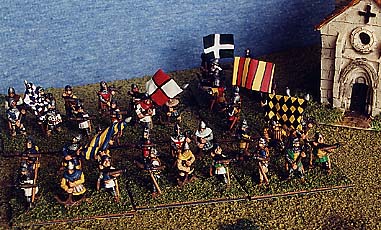
What Medieval army would be complete without a bunch of "revolting peasants?" These came in a bag of 100+ figures from, I believe, Feudal Castings (or Lancashire?). Levies like these were not actually much use on the battlefield, but could be quite handy in siege warfare. They would be tasked with digging the siege lines, tunneling, and advancing at the front as little more than human shields. On the battlefield, they seemed to serve little purpose other than to be slaughtered by the winning sides' horsemen. Basically, life sucked for these guys!
